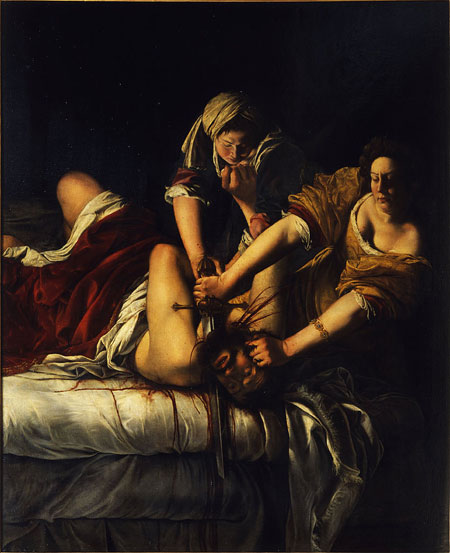Artemisia Gentileschi, Judith Slaying Holofernes

The story of Judith
Rivulets of blood run down the white sheets, as Judith, a pious young widow from the Jewish city of Bethulia, beheads Holofernes, general of the Assyrian army that had besieged her city. Moved by the plight of her people and filled with trust in God, Judith took matters into her own hands. She coiffed her hair, donned her finest garments and entered the enemy camp under the pretense of bringing Holofernes information that would ensure his victory. Struck by her beauty, he invited her to dine, planning later to seduce her. As the biblical text recounts, “Holofernes was so enchanted with her that he drank far more wine than he had drunk on any other day in his life” (Judith 12:20). Judith saw her opportunity; with a prayer on her lips and a sword in her hand, she saved her people from destruction.
The story of Judith and Holofernes is recounted in the Book of Judith, a 2nd century text deemed apocryphal by the Jewish and Protestant traditions, but included in Catholic editions of the Bible. Like the story of David and Goliath, it was a popular subject of art in the Renaissance and Baroque periods.
Artemisia and Caravaggio
This particular painting, executed by Artemisia Gentileschi in Florence c. 1620 and now in the Uffizi, is one of the bloodiest and most vivid depictions of the scene, surpassing the version by Caravaggio, arch-realist of Baroque Rome, in its immediacy and shocking realism. Artemisia was certainly familiar with Caravaggio’s painting of the subject; her father Orazio, who was responsible for her artistic training, was Caravaggio’s friend and artistic follower. Caravaggio’s painting inspired, and perhaps even challenged, the young Artemisia.
A comparison between the two reveals not only her debt to the older artist, but also a series of pointed modifications that heighten the intensity of the physical struggle, the quantity of blood spilled, and the physical and psychological strength of Judith and her maidservant, Abra. In Artemisia’s painting (below, right) the bloody sheets are in the immediate foreground, close to the viewer’s space. Holofernes’s muscular body projects dynamically into the depicted space as bold areas of light and dark draw attention to his powerful limbs.

And, most importantly, whereas Caravaggio (above, left) pairs his delicate Judith with a haggard attendant who merely looks on, her eyes wide with disbelief, Artemisia depicts two strong, young women working in unison, their sleeves rolled up, their gazes focused, their grips firm. Caravaggio’s Judith gracefully recoils from her gruesome task; Artemisia’s Judith does not flinch. Instead, she braces herself on the bed, as she presses Holofernes’s head down with one hand and pulls a large sword through his neck with the other. The creases at her wrists clearly show the physical strength required. Holofernes struggles in vain, the thrust of his arms countered by the more forceful movement of Abra, Judith’s accomplice in this grisly act.

Judith—Artemisia’s alter ego?
Artemisia’s unique portrayal of Judith and Abra has prompted scholars to argue that Artemisia identified with the protagonist of the story in a way her male counterparts did not. This association stems not only from their shared gender, but also from Artemisia’s own traumatic experience. Artemisia was raped at the age of 17 by the artist Agostino Tassi, a close friend of her father. When Tassi failed to marry her, as the social dictates of the time demanded, her father sought recourse in court. During the trial, Artemisia describes her struggle against Tassi and her attempt to attack him with a knife. She also recalls the sense of betrayal she felt when she realized her female chaperone had colluded with Tassi and arranged to leave the two alone.
The first version of Judith Slaying Holofernes dates to this difficult period in the artist’s life. The memory of this event likely colored Artemisia’s engagement with the story of Judith. Especially significant is Artemisia’s portrayal of Abra as youthful, strong and fully engaged in the assisting Judith, in striking contrast to the chaperone who purposefully abandoned Artemisia in her hour of need. In the Uffizi painting Artemisia adds a small detail that supports her identification with Judith. One of the cameos on Judith’s bracelet appears to depict Artemis, the ancient goddess of both chastity and the hunt.
Judith—A symbol of the Church Militant
The story of Judith was especially popular in the Baroque period, not only in the visual arts but also in literature, theater, and music. An example of the victory of virtue over vice, of God’s protection of his chosen people from their enemies, Judith was also seen as an Old Testament antetype of the Virgin Mary and, by extension, as a symbol of the Church. This association partly explains the increase in portrayals of Judith in late 16th through the 17th centuries.[1]
- Dr. Esperança Camara, "Artemisia Gentileschi, Judith Slaying Holofernes," in Smarthistory, July 19, 2015, https://smarthistory.org/gentileschi-judith-slaying-holofernes/. ↵

